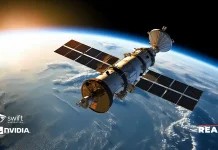With its observations of a special pair of stars at a special moment in their lives, the Stratospheric Observatory for Infrared Astronomy (SOFIA) is shedding new light on stardust.
Also Read: Built in Arkansas: LMXT Strategic Tanker Boom Refueling System to be Produced in Western Arkansas
Over an interval of 387 days, a giant star in the constellation Aquarius periodically has a dramatic change in its brightness. This is because the star falls into a category called Mira variables, which pulsate over long periods and surround themselves in a shell of dust.
But this isn’t just any Mira variable. The star is one of two in a binary star system known as R Aquarii, where it has a companion white dwarf. The two orbit one another, and the white dwarf crosses in front of the Mira variable every 43.6 years, causing an eclipse from the perspective of a viewer on Earth.
Another feature that’s special about R Aquarii is that the periastron, or the point in the orbit where the two stars are closest to each other, happens during the eclipse. This means that as the eclipse occurs – and the pair gets dimmer and dimmer, overall – the white dwarf and the Mira variable get closer and closer together. The white dwarf accretes more and more of the dust surrounding the Mira variable, and, because of this optimal geometry, we get to watch this process occur.
Since 2016, SOFIA, a joint project of NASA and the German Space Agency at DLR, has been monitoring the onset of the eclipse, which started in 2018, with periastron expected to occur in 2023. The flow of dust can be inferred at mid-infrared wavelengths, and SOFIA’s infrared camera, FORCAST, has just the right angular resolution to watch.
By combining what they know about the system – the distance between the two stars, the fact that an eclipse is ongoing, and predictions of how much dust there is – astronomers can figure out the balance between the amount of dust escaping the Mira variable and how much is being accreted by the white dwarf. These are “both very big questions,” said Ravi Sankrit, an astronomer at the Space Telescope Science Institute in Baltimore and first author on a recent paper published in The Astrophysical Journal about SOFIA’s 2018 and 2019 observations of R Aquarii.
USRA, under the auspices of the National Academy of Sciences at the request of the U.S. Government, the Universities Space Research Association (USRA), is a nonprofit corporation chartered to advance space-related science, technology and engineering. USRA operates scientific institutes and facilities, and conducts other major research and educational programs




